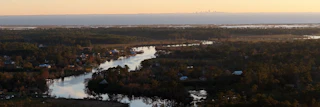

Case Study 3.
Homer

LEAN Region 7
Louisiana’s Florida parishes including the “North Shore” in southeast Louisiana:
- East Feliciana Parish
- Livingston Parish
- St. Helena Parish
- St. Tammany Parish
- Tangipahoa Parish
- Washington Parish
- West Feliciana Parish
About Mandeville
The northern shore of Lake Pontchartrain is a lush landscape filled with rivers, bayous and forested lands, having long been inhabited by indigenous tribes. In more modern times, the 'northshore' and St Tammany Parish have seen the growth of communities including Mandeville, Abita Springs, and Covington known for their beautiful environment. In 2014, Helis Oil Co. requested a permit to drill an exploratory well for natural gas northeast of Mandeville. Local residents concerned about potential impacts and expanding industrialization of the area formed an organization, Concerned Citizens of St Tammany, to challenge the permit. Particular concern arose from the company's plans to utilize hydraulic fracturing, or 'fracking'. After 2 years of hearings, public meetings, legal challenges and debate, Helis Oil abandoned its plans to develop the site.
Standards
Grade 8
CCSS-RI.1-8
Cite the relevant textual evidence that most strongly supports an analysis of what the text says explicitly as well as inferences drawn from the text.
CCSS-RI.2-8
Determine a central idea of a text and analyze its development over the course of the text, including its relationship to supporting ideas; provide an objective summary of the text.
CCSS-RI.6-8
Determine an author’s point of view or purpose in a text and analyze how the author acknowledges and responds to conflicting evidence or viewpoints.
Grades 9-10
CCSS-RI.1-9.10
Cite relevant and thorough textual evidence to support analysis of what the text says explicitly as well as inferences drawn from the text.
CC-RI.2-9.10
Determine a central idea of a text and analyze its development over the course of the text, including how it emerges and is shaped and refined by specific details; provide an objective summary of the text.
CCSS-RI.6-9.10
Determine an author’s point of view or purpose in a text and analyze how an author uses rhetoric to advance that point of view or purpose.
Grades 11-12
CCS-RI.1-11.12
Cite strong, thorough, and relevant textual evidence to support analysis of what the text says explicitly as well as inferences drawn from the text, including determining where the text leaves matters uncertain.
CC-RI.2-11.12
Determine two or more central ideas of a text and analyze their development over the course of the text, including how they interact and build on one another to provide a complex analysis; provide an objective summary of the text.
CCSS-RI.6-11.12
Determine an author’s point of view or purpose in a text in which the rhetoric is considered particularly effective, analyzing how style and content contribute to the student interpretation of power, persuasiveness, or beauty of the text.
Civics
C.9
Analyze the structure, roles, responsibilities, powers, and functions of government in the United States.
C.11
Analyze political processes and the role of public participation in the United States.
World History
WH.6
Evaluate the influence of science, technology, innovations, and explain how these developments have altered societies in the world from 1300 to 2010.
WH.22
Analyze trends of increasing economic interdependence and interconnectedness in world history from 1300 to 2010.
WH.24
Analyze the effect that humans have had on the environment in terms of resources, migration patterns, and global environmental issues.
World Geography
WG.7
Analyze how governments and political boundaries affect people and places.
Grade 8
8-MS-ESS3-3
Apply scientific principles to design a method for monitoring and minimizing human impact on the environment.
Earth Science
HS-ESS3-4
Evaluate or refine a technological solution that reduces impacts of human activities on natural systems.
Life Sciences
HS-LS2-7
Design, evaluate, and refine a solution for reducing the impacts of human activities on the environment and biodiversity.
Environmental Science
HS-ESS3-4
Evaluate or refine a technological solution that reduces impacts of human activities on natural systems.
Reading Resources
With Fracking Threatening Its Sole Drinking Water Source, A Coastal Community Fights Back
A Think Progress article detailing the unprecedented opposition from St. Tammany Parish residents against the proposed drill site by Helis.
Excerpt | Source
Helis to be a no-show at fracking meeting on Northshore
A WDSU article about Helis’ decision to not attend a public meeting regarding their proposed drilling site.
Excerpt | Source
Excerpt from Permit Documents for the Department of Natural Resources
Email correspondence between Lisa Jordan, Deputy Director of the Tulane Environmental Law Clinic and Patrick Courreges, Communications Director of LA Department of Natural Resources. Ms. Jordan is clarifying information regarding public commentary during an upcoming public meeting about the Helis drill site.
Source
Helis stops fracking project on North Shore
Article from New Orleans City Business.
Excerpt | Source
Drilling/fracking project in St. Tammany receives support of Northshore Business Council
Article from NOLA.com.
Source
Helis told to stop work on well for fracking project
WDSU news segment.
Source
St. Tammany Parish Council putting up money to continue fracking fight
WDSU news segment.
Source
Extended Reading Activity
Read With Fracking Threatening Its Sole Drinking Water Source, A Coastal Community Fights Back, watch Helis told to stop work on well for fracking project and analyze. Then discuss and answer the essential questions for this unit. Answers will vary to the questions, however students should be able to grasp the basic power dynamics of the situation.
Click here to access a worksheet of the essential questions.

